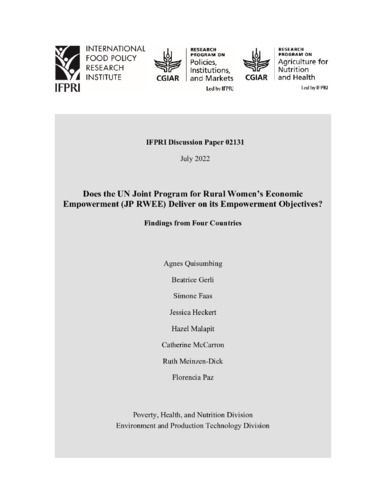Does the UN Joint Program for Rural Women’s Economic Empowerment (JP RWEE) deliver on its empowerment objectives?
Abstract
This paper compares the empowerment impacts of the UN Joint Program for Rural Women’s Economic Empowerment (JP RWEE) in Ethiopia, Niger, Nepal, and Kyrgyzstan using the Abbreviated Women’s Empowerment in Agriculture Index (A-WEAI). We assess the extent of empowerment and gender parity, and decompose the sources of disempowerment, separately for men and women and for beneficiary and control groups. We then estimate program impacts on A-WEAI and its component indicators and assess whether estimated impacts are consistent with the activities implemented by the program. We interpret the quantitative results in the light of the qualitative studies undertaken as part of the impact evaluation. Despite the diversity in country and cultural contexts, in all four countries, women are more disempowered than men, although large proportions of men are themselves disempowered. Excessive workload is the most common major contributor to disempowerment, and so is lack of group membership. The program had positive impacts on aggregate empowerment measures for program participants in Niger, Nepal, and Kyrgyzstan. Nevertheless, gender parity improved only in Nepal. The group-based approach was a clear contributor to women’s empowerment in Ethiopia, Nepal, and Kyrgyzstan. In Kyrgyzstan, the GALS/BALI approach contributed to impacts across almost all indicators of empowerment. The positive impact of GALS and GALS/BALI on men and women alike in Kyrgyzstan is consistent with emerging evidence that involving both men and women in gender transformative approaches, rather than focusing on women alone, may be key to effective and sustainable programs. Although impacts on time use were insignificant in the quantitative study, the qualitative work pointed out negative impacts, emphasizing the unintended consequences of increased workload for women who participate in livelihood interventions.

